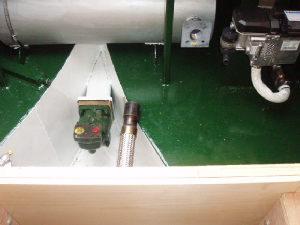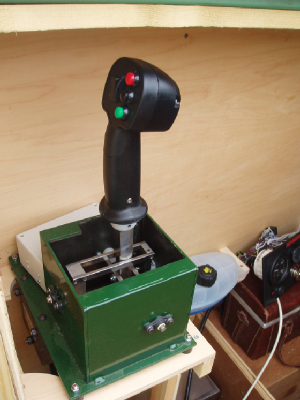|
Why Hydraulic Propulsion? The use of a hydraulic propulsion system for the main drive resulted from thinking about
the best way to power a bow thruster. Electrically powered bow thrusters suffer from some fairly limiting design features -
the motors often have a time limit on their operation otherwise they overheat. Also there is no control over their
speed and they require at least 2 large batteries close to the thruster because of the voltage drop in their cables.
Hydraulically powered bow thrusters can be used without limitation on operating time, moreover by using a proportional valve
to control it, the speed of the thruster may be varied to give the amount of thrust that is required. For these reasons
we took the positive decision to opt for hydraulic drive for the bow thruster.
To power the bow thruster with a conventional engine and drive system, a small hydraulic pump is mounted on the engine
and run by a belt drive. However, it occured to us that there might be advantages to using a larger hydraulic pump and
using another separate hydraulic motor to power the main propellor. Further investigation proved this to be the case and the
advantages and disadvantages of the system when compared to a conventional drive are outlined below:
Disadvantages:
- Increased fuel consumption - the use of hydraulics will result in a decrease of the drive systems efficiency by about
8%. However, the use of the "S" shaped swim will improve efficiency and so the losses should only be about 6% although
this cannot be quantified.
Advantages:
- No gearbox, propellor shaft, gland seal or bilge pump. Hence, no alignment problems, no water dripping into the
bilge no more greasing of the seal at the end of a days cruising, no vibration and a clean, and perhaps more important, a
dry engine compartment.
- The use of a proportional valve to control the propellor means that the propellor rpm may be varied from zero to
full speed in either direction making low speed manoeuvering very easy. In an emergency, unlike a conventional gearbox,
an instantaneous change from full ahead to full reverse is also possible without any risk of damage to the drive system.
- A joystick control for both the bow thruster and the main propulsion means that the boat is easier and more precise to
control and the limitations of the tiller/joystick interface unit are not exceeded - it only has 2
hands!!. (If you have never heard of the tiller/joystick interface unit before another
name for it is "the helmsman")
- Hydraulic power is available for other uses such as lifts for invalid access.
- Reduced maintenance costs - the hydraulic system is almost maintenance free as opposed to the maintenance that is required
with a gearbox, propshaft, sterngland and bilge pump.
|
 |

The hydraulic motor for the main propulsion showing
the simplicity and neatness of the installation.
The Joystick that controls the main propulsion and the bow thruster. The three buttons control the throttle and
the horn. The red button increases the engine rpm whilst the green button decreases it and the black button sounds the
horn. The switch controls the tunnel light. Hence, all the controls that are required by the helmsman are grouped
together and close at hand.

The joystick during build minus its protective
cover.
Hercules Hydraulics may be contacted by e-mail at steve@hercules.org.uk or through their web site at www.hercules.org.uk
|

